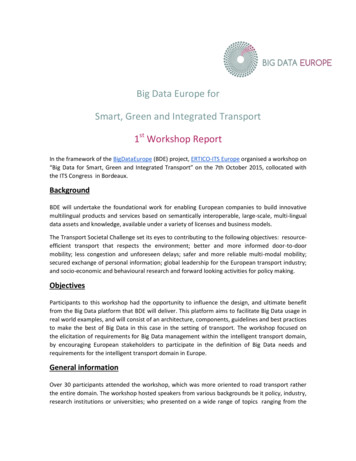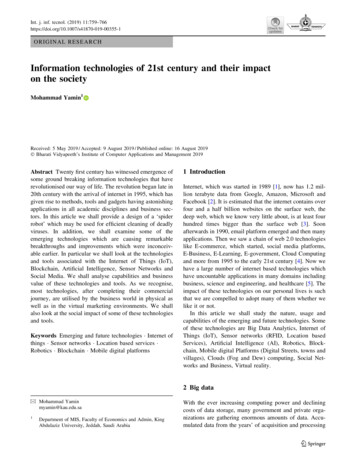
Transcription
Big Data Europe forSmart, Green and Integrated Transport1st Workshop ReportIn the framework of the BigDataEurope (BDE) project, ERTICO-ITS Europe organised a workshop on“Big Data for Smart, Green and Integrated Transport” on the 7th October 2015, collocated withthe ITS Congress in Bordeaux.BackgroundBDE will undertake the foundational work for enabling European companies to build innovativemultilingual products and services based on semantically interoperable, large-scale, multi-lingualdata assets and knowledge, available under a variety of licenses and business models.The Transport Societal Challenge set its eyes to contributing to the following objectives: resourceefficient transport that respects the environment; better and more informed door-to-doormobility; less congestion and unforeseen delays; safer and more reliable multi-modal mobility;secured exchange of personal information; global leadership for the European transport industry;and socio-economic and behavioural research and forward looking activities for policy making.ObjectivesParticipants to this workshop had the opportunity to influence the design, and ultimate benefitfrom the Big Data platform that BDE will deliver. This platform aims to facilitate Big Data usage inreal world examples, and will consist of an architecture, components, guidelines and best practicesto make the best of Big Data in this case in the setting of transport. The workshop focused onthe elicitation of requirements for Big Data management within the intelligent transport domain,by encouraging European stakeholders to participate in the definition of Big Data needs andrequirements for the intelligent transport domain in Europe.General informationOver 30 participants attended the workshop, which was more oriented to road transport ratherthe entire domain. The workshop hosted speakers from various backgrounds be it policy, industry,research institutions or universities; who presented on a wide range of topics ranging from the
role of social media in transport, over open logistics and traffic management to data analysestechniques.The workshop consisted of three sessions dedicated respectively to data-centric initiatives intransport, big data use-cases in transport, and technologies and tools used and envisaged. Talks inthese sessions were followed by three breakout sessions; dedicated to policy, business, and dataand technology respectively. The workshop was concluded following a summary of discussions andresults in the three parallel sessions .Agenda9:00Official WelcomeMaxime Flament, ERTICO – ITS EuropeOpening Session9:15Big Data for Transport – Why Does it Matter?9:30What can big data do for transport?Paul Timmers, European CommissionSimon Scerri, Fraunhofer IAISSession 1: Data-centric Initiatives in Transport9:40Big Data Sources For/From Intelligent RoadTransport: An overview9:50The use of big data for public transportperformance measurement10:00The role of social media in transport10:15Evangelos Mitsakis, CERTHRoberto Baldessari, NECDave Marples, TechnolutionCoffee breakSession 2: Big Data Use-cases in Transport10:25Open LogisticsGerman Herrero, ATOS10:35Real-time Trafficmanagement10:45How to deal with all the data that is generatedby the vehicle sensors?informationandtrafficNick Cohn, TomTomSean Gaines, VicomtechSession 3: Technologies and Tools used andenvisaged10:55Existing tools and technologies used acrossother sectors11:05Data Analyses in TransportSimon Scerri, Fraunhofer IAISHelena Gellerman, Chalmers University
Breakout SessionsLeader of the Business group: Dave Marples, Technolution11:20Leader of the Policy group: Giselle Roesems, DG CONNECTLeader of the Data & Technology group: Sean Gaines, Vicomtech12:3012:55Breakout session reportsClosing noteData-centric Initiatives in TransportThe first of three sessions dealt with data-centric initiatives in transport. The use of big and opendata in the transport sector is relevant for governments (traffic control, planning and modeling,route planning, congestion management, etc.), for the private sector (travel industry, routeplanning and logistics, competitive advantages, etc.) and for individuals (route and travelplanning).Big data plays an important role in how smart cities obtain their transportation targets, meaninghow smart cities use and deploy ICT to enhance their transportation networks. Big data intransport will lead to improved multi-source traffic and travel data availability and processing, andto tools to enhance multi-source traffic and travel data fusion for, for instance, improved trafficand mobility management. Combining big, open and linked data will leverage innovation andeconomic benefits.Big data is important for traffic management: it provides new insights into traffic patterns, realtime traffic data to information service providers. In public transport, bid data helps to understandtravelers’ journey patterns, informing transport agencies and operators on how different socialgroups use the public transport system. Big data for private travelers enables personalisedinformation (such as delays). Finally, big data can also be used for asset maintenance offering newopportunities to identify problems more quickly and reduce costs.Big data is highly valuable to monitor of public transport performance. Currently data analytics usepublic transport Key Performance Indicators such as Excess Waiting Time (EWT) in order tomeasure the contractual performance of the public transportation companies. They reveal theworst performing routes, key bottlenecks on the routes, causes for dwell time at bottlenecks andtime table improvement margins. Based on this, bus operators and municipalities/authorities canhave an EWT profile based on their public transit scores. Simple analytics derive hot spots toattack in order to reduce EWT.Social media play an important role in transport with continuous, inbound information (stimulusto traffic control) and outbound information (stimulus to road user). Open questions relate to howto decide which social media inflows are reliable and to what degree, what degree does the factthat social media sources are electively published give users open rights to use them, how to
prevent spoof outflows from confusing or malicious users, and how to prevent beneficial servicesencouraging inappropriate use of social media apps.Big Data Use-cases in TransportThe first use-case discussed in this session was Open Logistics. The use of big data can lead toefficiency gains in the logistics chain. Manufacturers are looking at big data as a catalyst forgreater collaboration, enabling more complex supplier networks that focus on knowledge sharingand collaboration as added value. Big data and advanced analytics are being integrated intooptimisation tools, demand forecasting, integrated business planning and supplier collaboration &risk analytics at a quickening pace. Big data also contributes to the delivery process.The second use-case considered was Real-time Traffic Management. Big data allows warningsahead of jams, HOV lane handling, traffic flow predictions, etc. Going from big data to active trafficmanagement requires merging big data with data from fixed sources. The use of archived dataallows to improve individual route planning, to measure bottlenecks and delays, to measuresystem reliability, to determine priorities for infrastructure improvement, and to analyse theimpact of the investments made.The third use-case focused on how to deal with the data generated by vehicle sensors. Data cancome from external and internal cameras each with 360 viewing. Data fusion beyond 720 viewing allows Holistic Driving Models, Personalised Driving Models, HMI response, ContinuousMonitoring, etc.Technologies and Tools used and envisagedIn the context of data analysis in transport, the tools and process in the Field Operational Test(FOT) analysis platform were presented. FOTs generate complex data, subjective and contextualdata. As a next step, data is processed using HPC and is hosted in databases and files for video. Afuture big data platform must allow real-time data analysis (instead of research), includevisualisation tools that allow data mining and analysis results, automatic video coding data sentover GPRS/Wi-Fi to cloud based storage, efficient data structures to allow efficient data extraction,and will need to support open repositories with high quality context information.The ultimate goal of the BDE is to design and build a platform that can benefit not only thetransport domain but also a variety of other societal challenges. Therefore the presentations ofthe workshop were wrapped up by Fraunhofer, as project coordinator. Big data involves theanalysis of historical data, analysis of actual data with low latency in “real-time”, and interactiveanalysis by online queries. The question is how this can all be put together in one big datamanagement system. Fraunhofer presented a blueprint of the data aggregator platform thatfollows the typical Lambda architecture, and utilizes existing solutions such as BigTop components.Breakout sessionsThe three sessions were followed by three parallel breakout sessions focusing on policy, businessand data and technology. Each breakout session saw the participation of between 5 and 12participants.
PolicyThe Policy session discussed privacy issues, the role of the public authorities to make dataavailable to the service providers, issues regarding the use of data (how to allow to link and diginto these data), and the public/private role regarding standardisation. If a common standard willbe developed, it should be a non-discriminatory standard with open APIs. Policy makers shouldalso provide clarity on the re-use rights of data. The session discussed the issue of contractobligations and whether guidance from policy makers is required to bind a user to one singleservice. Participants agreed that there should be a “free flow of data initiative” in the EU. The EUshould also promote the use of open data. The session discussed the public-private role withregard to data centre regulations: should the market decide or should there be a service levelagreement. The policy sessions discussed the tools needed and better guidelines, on how toanonymise and aggregate data; better guidance, understanding and control of big data; principlesof privacy design, and a checklist for testing if privacy for design is respected. The EU should alsoprovide guidance on whether the transport sector should have a transport-specific privacyframework or keep the general framework.BusinessThe Business breakout session discussed how current businesses are challenged by big data. Anissue is to have the right mindset to make data available in the first place. Making data availablealso involves a risk factor. An education/outreach process to the public at large is required.Through use-cases, people must be made aware that good things can happen. The process willrequire a political leap of faith and brave policy makers. It is also important to publicise the factthat specific data is available. Business models will arise from those who can turn data into usableinformation. The market must become better at turning data into information. The quality of theoutput is important: the higher quality the higher the market value of the data. Current businesseswill be challenged by big data. Ultimately the user will choose which services will survive.Data & TechnologyThe Technology break-out session discussed the cross-domain nature of transport data use-cases,which involve psychologists, road engineers, vehicle engineers etc. Discussions revealed that theBDE project’s role is to quiz the societal challenge domains, including the transport sector, topropose technical solutions without their clear understanding of the underlying problem. Theresults will be converted to architectural and design requirements. The session discussed the threetransport data dimensions and data types including Infrastructure (dynamic maps/attributes,maintenance, operational, foresight), Vehicle (location, driver monitoring, performance andtelemetry) and Users (events, state, behaviour and personal activity). Each of these dimensionsand data types were evaluated against the three core Big Data V’s: Volume, Velocity and Variety.The results are summarised in the table below. Open issues relate to unforeseen events, diversedata formats, common understanding (lack of), and scalability / volume issues.
InfrastructureVehiclePrivate UsersVolumeVarietyVelocityDynamic Maps/Attributes - Maintenance-- Operational Foresight?Location - Driver Monitoring00 Performance Telemetry -Events? State-- Behaviours- Personal Activity- ConclusionsThis workshop was organised in order to elicit and better understand the requirements that theTransport Societal Challenge poses on a future Big Data infrastructure in Europe. This is not alwaysstraightforward since frequently, people involved in the sector do not even have a completeunderstanding of the big data challenges, and therefore struggle to identify ideal solutions. Theoutcome of the workshop will therefore feed the requirements elicitation phase of the BDEproject, ahead of developing the first prototypes and the selection and initiation of pilots that areto be implemented. The workshop results indicate that there is a clear need for Big Data solutionsin Transport, but that there are also very diverse areas for application. Moreover, this firstworkshop mainly focussed solely on road transportation. At the same time, it was evident thatstakeholders are asking some questions which remain unanswered. This confirms that there is aneed for more Big Data expertise to contribute to the transport fields with guidance and best
practices. There was also an emphasis on understanding how to better control and measure thequality of the information.In view of the foreseen Big Data architecture and implementation, it is important to eventuallypropose generic tools and expertise which will answer a broad scope of transportation topics fromlogistics, public transport to traffic management. A basis is to convince the transport stakeholdersto contribute to the creation of large pools of well-documented and accessible road data, i.e.,open and with known velocity, volume and variety. In some sectors within Transport and someregions, this is well understood and we see that opening the data often brings added-valueservices. By providing expertise, more flexible tools and demonstrations, the BigDataEuropeproject will help to convince authorities and other players to open their data and focus on buildingnew services for the end users.One of the major cross-sectoral concerns is the protection of private data, especially any geolocated data. Here, the project could help by outlining best practices of how to deal with privacyprotection while preserving the data’s value.Links to other MaterialThe slides from the various talks are available on slideshare. Photos from the event are availableon Flickr. Additional information was reported on the BDE Website and W3C interest group.Report by Marie de Rycke, Maxime Flament, Andrea Toth (ERTICO-ITS Europe); and Simon Scerri(Fraunhofer IAIS).
Big data plays an important role in how smart cities obtain their transportation targets, meaning how smart cities use and deploy ICT to enhance their transportation networks. Big data in transport will lead to improved multi-source traffic and travel data availability and processing, and to tools to enhance multi-source traffic and travel data .










